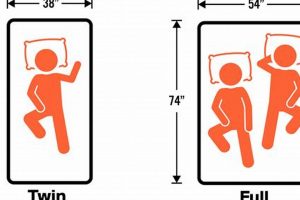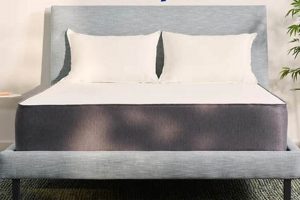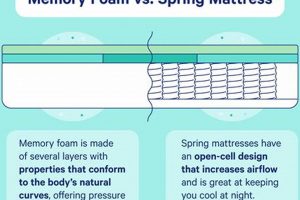The selection of sleep surfaces often involves a consideration of comfort levels. One common decision involves choosing between a yielding, soft feel and a resilient, supportive feel. This choice impacts spinal alignment, pressure point relief, and overall sleep experience.
The importance of selecting the appropriate sleep surface stems from its direct influence on sleep quality and physical well-being. Historically, preferences have varied widely based on cultural norms, individual needs, and evolving material technologies. The chosen level of support can mitigate back pain, improve circulation, and contribute to restorative sleep.
Understanding the characteristics of differing mattress feels allows individuals to make informed decisions tailored to their specific needs. The following sections will explore the features, benefits, and suitability of options on opposite ends of the firmness spectrum.
Guidance on Selecting Mattress Firmness
The following recommendations are intended to assist in making an informed decision regarding mattress firmness, focusing on individual needs and preferences to promote optimal sleep and spinal health.
Tip 1: Consider Sleeping Position. Side sleepers generally benefit from surfaces that contour to the body, allowing for spinal alignment and pressure relief on hips and shoulders. Back sleepers often require a balance of support and cushioning to maintain natural spinal curvature. Stomach sleepers typically need firmer support to prevent excessive sinking of the midsection.
Tip 2: Evaluate Body Weight and Build. Individuals with higher body weights may require a firmer surface to ensure adequate support and prevent excessive compression. Lighter individuals may find softer surfaces more comfortable, as they allow for appropriate contouring without feeling overly rigid.
Tip 3: Assess Pressure Point Sensitivity. Individuals experiencing discomfort or pain in specific areas, such as hips, shoulders, or back, should consider surfaces designed to alleviate pressure points. Memory foam and latex materials are known for their pressure-relieving properties.
Tip 4: Factor in Co-Sleepers’ Preferences. When sharing a bed, it is essential to find a compromise that accommodates both individuals’ needs. Consider options with motion isolation features to minimize disturbance from movement.
Tip 5: Trial Period Utilization is Crucial. Take advantage of any trial periods offered by retailers. Sleeping on a mattress for an extended period is the most effective way to determine if it provides adequate support and comfort.
Tip 6: Medical Conditions Should Influence Choice. Individuals with specific medical conditions, such as back pain, scoliosis, or arthritis, should consult with a healthcare professional to determine the most suitable mattress firmness.
Sound mattress selection involves careful consideration of individual factors. Prioritizing spinal alignment, pressure relief, and personal comfort leads to enhanced sleep and overall well-being.
With this guidance in mind, the subsequent sections will explore the specific benefits and drawbacks of different mattress types.
1. Spinal Alignment
Maintaining proper spinal alignment during sleep is paramount for musculoskeletal health and restorative rest. The support offered by a sleep surface profoundly impacts the spine’s natural curvature, either promoting healthy alignment or exacerbating existing issues. Surface firmness plays a crucial role in this dynamic.
- Support for Natural Curvature
The human spine has natural curves that must be maintained while lying down. A surface that is too soft allows the body to sink, disrupting the natural curvature and potentially leading to back pain. A surface that is too firm may not conform to the body’s contours, creating pressure points and preventing proper alignment. The ideal firmness level provides sufficient support to maintain these curves without excessive sinking or pressure.
- Influence on Different Sleeping Positions
Sleeping position significantly dictates the necessary support level. Side sleepers generally require a softer surface to accommodate the shoulders and hips, allowing the spine to remain aligned. Back sleepers benefit from a medium-firm surface that supports the lower back and prevents the hips from sinking too far. Stomach sleepers typically need a firm surface to prevent excessive arching of the lower back.
- Impact on Pressure Point Relief
Pressure points occur when certain areas of the body bear excessive weight, leading to discomfort and potential circulatory issues. While firm surfaces may provide ample support, they can exacerbate pressure points, particularly at the shoulders and hips. Softer surfaces contour to the body, distributing weight more evenly and reducing pressure point discomfort. However, excessive softness can compromise spinal alignment.
- Long-Term Musculoskeletal Health
Consistent misalignment of the spine during sleep can contribute to chronic back pain, neck pain, and other musculoskeletal problems. Selecting a mattress that promotes proper alignment is a proactive step in maintaining long-term spinal health. The chosen firmness level should be based on individual needs and preferences, taking into account sleeping position, body weight, and any existing spinal conditions.
The relationship between spinal alignment and surface firmness is complex and highly individual. A careful assessment of personal needs and preferences, combined with a thorough understanding of the support characteristics of varying firmness levels, is essential for making an informed decision that promotes both comfort and musculoskeletal well-being.
2. Pressure Relief
Pressure relief, in the context of sleep surfaces, pertains to the mattress’s ability to minimize concentrated force on specific areas of the body. This is a critical consideration when differentiating between varying firmness levels. Firmer surfaces, while offering support, can create concentrated pressure points, particularly at bony prominences such as the hips, shoulders, and knees. This concentrated pressure restricts blood flow and triggers discomfort, potentially leading to tossing and turning throughout the night, thereby disrupting sleep cycles. Conversely, plusher surfaces are designed to conform to the body’s contours, distributing weight more evenly and reducing pressure on these sensitive areas. The effectiveness of pressure relief directly impacts sleep quality and can alleviate pain associated with certain medical conditions, such as arthritis or fibromyalgia.
The materials used in mattress construction significantly contribute to pressure relief capabilities. Memory foam, for example, is specifically engineered to mold to the body, providing a customized level of support and weight distribution. Latex mattresses also offer pressure relief, although they typically provide a more responsive feel compared to memory foam. In contrast, traditional innerspring mattresses may offer less pressure relief, particularly those with a thinner comfort layer. Real-world examples include individuals with chronic back pain reporting reduced discomfort and improved sleep quality after switching to a mattress with enhanced pressure-relieving properties. Additionally, side sleepers often benefit significantly from plusher surfaces that alleviate pressure on the shoulder and hip joints, preventing pain and stiffness.
Effective pressure relief is a fundamental component of a comfortable and restorative sleep experience. While firmer surfaces may be preferred for spinal alignment in certain sleeping positions or for individuals with specific needs, the potential for increased pressure points must be carefully considered. The ideal mattress strikes a balance between support and pressure relief, catering to individual preferences while promoting overall musculoskeletal health. Understanding the relationship between surface firmness and pressure distribution is essential for making an informed decision that prioritizes both comfort and long-term well-being.
3. Support Level
The support level provided by a mattress directly correlates with its firmness and is a critical factor in determining its suitability for individual needs. A mattresss ability to maintain spinal alignment and distribute weight evenly hinges on the degree of support it offers, impacting overall sleep quality and musculoskeletal health.
- Core Construction and Materials
The core construction of a mattress, whether innerspring, foam, or hybrid, dictates its inherent support capabilities. Innerspring systems offer varying degrees of support based on coil gauge and design. Foam cores, particularly those utilizing high-density foams, provide consistent and contouring support. Hybrid mattresses combine these elements, aiming to balance responsiveness and support. The chosen materials and construction significantly influence the mattress’s ability to prevent sagging and maintain its shape over time. For example, a low-density foam core may compress prematurely, diminishing support and potentially leading to discomfort.
- Weight Distribution and Pressure Mapping
Effective support ensures even weight distribution across the sleep surface, minimizing pressure points and promoting proper spinal alignment. A mattress with inadequate support may concentrate weight in specific areas, leading to discomfort and restricted circulation. Pressure mapping technology can illustrate how a mattress distributes weight, revealing potential areas of concentrated pressure. Heavier individuals generally require a higher support level to prevent excessive sinking and maintain spinal alignment. Conversely, lighter individuals may find overly supportive mattresses uncomfortable due to a lack of contouring.
- Edge Support and Usable Surface Area
Edge support refers to the stability of the mattress perimeter. Strong edge support maximizes the usable sleep surface and prevents the feeling of rolling off the bed. Inadequate edge support can be particularly problematic for individuals who share a bed or who tend to sleep near the edge. Reinforced edges, often achieved through the use of high-density foam or additional coils, enhance the mattress’s structural integrity and provide a more stable sleeping surface. The absence of adequate edge support can also make it more difficult to get in and out of bed, particularly for individuals with mobility issues.
- Long-Term Durability and Sagging Prevention
The long-term durability of a mattress is directly related to its ability to maintain its support level over time. Sagging, a common issue with older mattresses, compromises support and can lead to discomfort and pain. High-quality materials and construction techniques contribute to a mattress’s longevity. Rotating the mattress regularly can also help to distribute wear evenly and prolong its lifespan. Mattresses with a low-quality support core are more prone to sagging, requiring more frequent replacement.
The appropriate support level is a highly individual consideration, dependent on factors such as sleeping position, body weight, and personal preferences. When choosing between different firmness levels, individuals must carefully evaluate how each option impacts spinal alignment, weight distribution, and overall comfort. Selecting a mattress with adequate support is crucial for promoting restorative sleep and preventing musculoskeletal issues.
4. Sleeping Position
Sleeping position significantly influences the subjective experience of mattress firmness and its impact on spinal alignment. Individual posture during sleep dictates pressure distribution and the degree of support required for optimal comfort and musculoskeletal health. The correlation between sleeping position and preferred surface feel is a primary consideration in mattress selection.
- Side Sleeping and Pressure Relief
Side sleeping concentrates pressure on the shoulders and hips. Softer surfaces are generally recommended to allow these areas to sink into the mattress, maintaining spinal alignment and minimizing pressure point discomfort. A surface that is too firm can exacerbate pressure, leading to restless sleep and potential pain. Real-world examples include individuals with shoulder pain finding relief on plusher mattresses that contour to their body shape. Conversely, a surface that is too soft may not provide adequate support, resulting in spinal misalignment.
- Back Sleeping and Spinal Support
Back sleeping requires a balance of support and cushioning to maintain the spine’s natural curvature. Medium-firm surfaces are often preferred, as they provide sufficient support to prevent the hips from sinking too far while still offering some degree of contouring. A surface that is too firm may not conform to the lower back, creating pressure points. A surface that is too soft may allow the hips to sink excessively, leading to lower back pain. Individuals with existing back conditions often require a more supportive surface to maintain proper alignment.
- Stomach Sleeping and Spinal Alignment
Stomach sleeping is generally discouraged due to its tendency to flatten the natural curve of the spine and place stress on the neck. If this position is unavoidable, a firmer surface is typically recommended to minimize sinking of the midsection and prevent excessive arching of the lower back. A softer surface can exacerbate spinal misalignment in this position. Individuals who primarily sleep on their stomach should consider strategies to transition to a side or back sleeping position, as this is generally considered healthier for the spine.
- Combination Sleeping and Compromise Solutions
Many individuals shift between multiple sleeping positions throughout the night. In such cases, a medium-firm surface that offers a balance of support and contouring may be the most suitable choice. Hybrid mattresses, which combine different materials to achieve a balance of firmness and pressure relief, can be particularly effective for combination sleepers. Compromise solutions may also involve the use of mattress toppers to fine-tune the firmness level and provide customized comfort.
The influence of sleeping position on perceived mattress firmness highlights the importance of individual testing and careful consideration of personal needs. Selecting a mattress that aligns with one’s primary sleeping position can significantly enhance sleep quality and promote long-term musculoskeletal health. While general recommendations exist, individual preferences and specific physical conditions should ultimately guide the decision-making process.
5. Individual Preference
Subjective comfort, driven by individual physiological and psychological factors, significantly influences mattress firmness selection. While objective factors like spinal alignment and pressure relief are crucial, personal preference often dictates the ultimate satisfaction with a sleeping surface. Neurological responses to tactile sensations, prior experiences with different mattress types, and even deeply ingrained sleep habits shape an individual’s perception of comfort. For instance, one person may associate a yielding surface with relaxation and ease, while another may perceive the same surface as lacking support and contributing to feelings of unease. This variability underscores the importance of considering subjective factors alongside objective criteria when choosing between differing levels of firmness.
The role of individual preference extends beyond mere comfort perception; it can impact sleep quality and overall well-being. A surface deemed uncomfortable due to personal preference can lead to restless sleep, increased stress levels, and even exacerbation of existing physical ailments. Consider a scenario where a person with a history of sleeping on firmer surfaces transitions to a plusher mattress based solely on recommendations for pressure relief. Despite the potential benefits for pressure point reduction, the unfamiliar sensation and perceived lack of support may lead to anxiety and sleep disruption. Conversely, an individual accustomed to softer mattresses may find a firmer surface unyielding and uncomfortable, negating any potential benefits for spinal alignment. Therefore, a holistic approach to mattress selection necessitates a careful consideration of individual preference, taking into account past experiences, ingrained habits, and subjective comfort assessments.
In conclusion, while objective factors provide a framework for understanding the biomechanical aspects of mattress firmness, individual preference serves as a critical modifier, shaping the overall sleep experience. The challenge lies in balancing objective recommendations with subjective needs, ensuring that the chosen surface promotes both physical health and personal comfort. Understanding the significance of individual preference is paramount for promoting informed decision-making and maximizing satisfaction with sleep surface selection, leading to improved sleep quality and enhanced overall well-being.
Frequently Asked Questions
The following questions address common inquiries regarding mattress firmness, providing informative answers to aid in the selection process.
Question 1: Does surface firmness directly correlate with support?
While surface firmness contributes to the perception of support, it is not the sole determinant. The internal construction and materials used within the mattress core are also critical factors in providing adequate support and preventing sagging.
Question 2: Is a softer surface always better for side sleepers?
While softer surfaces generally accommodate side sleepers by allowing the shoulders and hips to sink in, individual needs vary. A surface that is too soft may not provide adequate spinal support, even for side sleepers. A balance between contouring and support is optimal.
Question 3: Can a firm mattress exacerbate back pain?
Yes. While firmer mattresses are often recommended for back support, a surface that is too firm can create pressure points and disrupt spinal alignment, potentially worsening back pain. Individuals with existing back conditions should consult with a healthcare professional.
Question 4: How does body weight influence the ideal surface firmness?
Individuals with higher body weights generally require a firmer surface to prevent excessive sinking and maintain proper spinal alignment. Lighter individuals may find softer surfaces more comfortable, as they allow for adequate contouring without feeling overly rigid.
Question 5: Is there a single “best” level for all individuals?
No. The ideal firmness level is subjective and depends on a combination of factors, including sleeping position, body weight, personal preferences, and any existing physical conditions. Individual testing and careful consideration are crucial.
Question 6: How can one assess mattress firmness before purchasing?
Whenever possible, physically testing the mattress in a store is recommended. Online retailers often offer trial periods, allowing individuals to assess the mattress’s suitability in their own home. Reading reviews from individuals with similar needs can also provide valuable insights.
Selecting the appropriate firmness requires careful consideration of individual needs. Considering factors such as sleeping position, body weight, and personal preferences is paramount.
The following sections will explore specific mattress types and their suitability for different individuals.
Plush Mattress vs Firm
The preceding exploration has illuminated the multifaceted considerations inherent in selecting the appropriate mattress firmness. The critical distinction between a yielding sleep surface and a resilient one extends beyond mere preference, directly impacting spinal alignment, pressure point relief, and ultimately, the restorative nature of sleep. Individual sleeping position, body weight, and pre-existing physical conditions necessitate a nuanced approach to surface selection.
The choice between a plush mattress vs firm remains a pivotal decision in the pursuit of optimal sleep and long-term musculoskeletal health. Individuals are encouraged to engage in thorough self-assessment and, when feasible, in-person testing to ascertain the surface that best aligns with their unique needs. Prioritizing informed decision-making in this domain is a proactive investment in well-being.



![Firm vs Plush Mattress: Find Your Best Sleep [Guide] Organic & Natural Mattress Buyer’s Guide: Non-Toxic Sleep Solutions Firm vs Plush Mattress: Find Your Best Sleep [Guide] | Organic & Natural Mattress Buyer’s Guide: Non-Toxic Sleep Solutions](https://mattressworldpa.com/wp-content/uploads/2025/07/th-1112-300x200.jpg)



